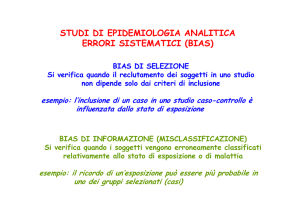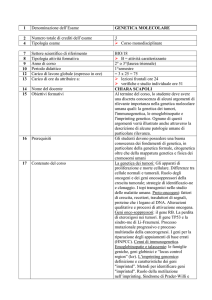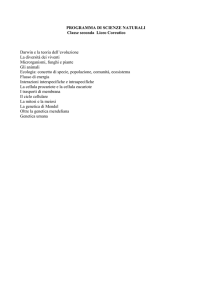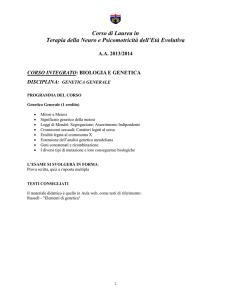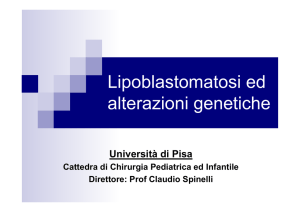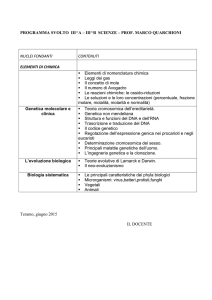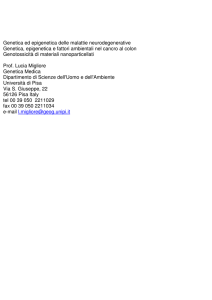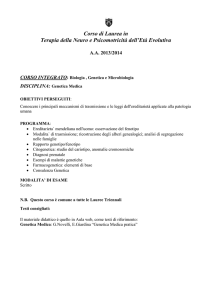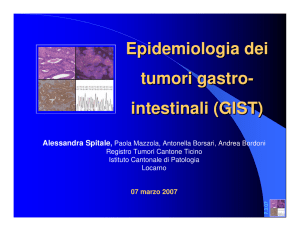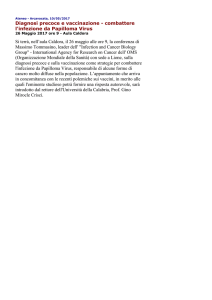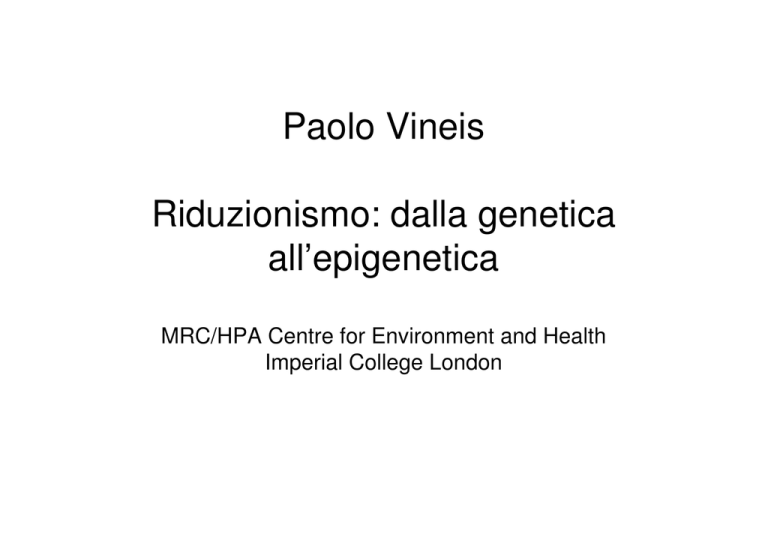
Paolo Vineis
Riduzionismo: dalla genetica
all’epigenetica
MRC/HPA Centre for Environment and Health
Imperial College London
Che cosa e’ il riduzionismo
Una posizione filosofica secondo cui un sistema
complesso e’ interamente spiegabile dalla somma
delle sue parti (per estensione: fenomeni
complessi posso essere ridotti e spiegazioni
materiali semplici, per es. i comportamenti alla
genetica, la scelta morale alla biochimica del
cervello)
Una critica classica al riduzionismo – Willard Van
Orman Quine “Due dogmi dell’empirismo” (1951)
Premessa: sono in gioco (a) osservazioni
scientifiche; (b) teorie/modelli; (c) le loro
“implicazioni” (anche etiche) - e le loro relazioni
Ormai e’ ampiamente accettato che le
osservazioni sono cariche di teoria: Stegmuller
Alcuni esempi:
- I test genetici e la loro predittivita’
- la teoria del determinismo biologico e la
responsabilita’ individuale (Caspi)
Una classica controversia:
“Nature and Nurture”, geni e
ambiente
Qualche notizia sugli avanzamenti della genetica
molecolare e dell’epidemiologia genetica:
- il dogma “un gene-una proteina” non e’ piu’ vero:
“alternative splicing”
- la maggior parte delle malattie sono poligeniche
(cfr cancro e diabete)
- la regolazione/modulazione della espressione –
e non solo la sequenza - del DNA sta acquisendo
grande rilevanza (epigenetica)
Solo alcune rare forme di suscettibilità
monogenica sono ad “alta penetranza”, cioè il
rischio di malattia è aumentato di 10 o piu’ volte
nei portatori (es BRCA1 nel cancro della
mammella)
Perlopiù la suscettibilità genetica al cancro è
affidata a geni a bassa penetranza, cioè con bassa
potenza
I tumori sono dovuti principalmente a influenze
ambientali (NB= cosa intendiamo?), su cui si
inserisce la suscettibilità genetica (interazioni geniambiente)
30
925
Odds Ratio
20
715
Reported Risk Allele Frequencies by
Odds Ratios for Discrete Traits
Sarasquete
Osteonecrosis
Thorlieifsson
Exfoliation
Glaucoma
10
Hakonarson
Type 1 DM
4
van Heel
Celiac Disease
55
33
WTCCC
Type 1 DM
2
11
0.0
0.2
0.4
0.6
Risk Allele Frequency (%)
0.8
1.0
Who cares about an OR=1.25?
OR = odds ratios, calculated with a simple additive model. For example, for subjects with 10
risk alleles the relative risk would be 3.5. These subjects would represent 13% of the
population, and over 54% of the population would carry 10 risk alleles or more.
Vineis P et al, Expectations and challenges stemming from genome-wide association studies, Mutagenesis 2009
071012
Calculation of the number needed to screen for a
hypothetical low-penetrant gene among subjects
exposed to arsenic.
Gene
Wild-type
Variant
Relative risk for gene
Cumulative risk of
cancer
Risk reduction %
Cumulative risk after
intervention
Absolute risk reduction
NNT
Carrier frequency
NNS
1.0
1.5
1%
50%
1.5%
50%
0.5%
0.5%
200
80%
0.75%
0.75%
133
20%
666
Ethics of Genetic Testing
Paolo Vineis, Habibul Ahsan, Michael Parker
Genetic screening and occupational and
environmental exposures: Scientific and ethical
issues OEM, 2005
The key set of arguments against the use of genetic
screening and testing in the workplace is that this is
a distraction from the responsibility of employers
and legislators to ensure that the working
environment is safe for all of those who work there.
Instead of using resources to identify workers who
are less at risk, the focus should be on finding ways
to make the workplace safe for all.
Less attention in reducing exposure levels
can affect not only people in the working
environment but also patients of a GP: e.g.
people with the “wildtype” can decide not to
quit smoking
(www.sciona example)
http://www.sciona.com/coresite/index
The future: epigenetics?
Conrad H. Waddington
Epigenetic mutations are coupled with
environmental changes.
Epigenetic mutations control the shapes and
functions of organisms.
Epigenetics – Philosophical insight
e.g.: Nickel, Cadmium, Arsenic:
carcinogenicity also involves DNA
hypermethylation and histone
deacetylation, both of which contribute to
heterochromatin condensation and the
epigenetic silencing of some genes.
Impressive rediscovery
of the influence of environmental agents
on gene expression.
Uses of epigenetics in
environmental epidemiology
Identification of environmental fingerprints:
- aspecific such as global hypomethylation
(detected in reporters such as LINE-1 and
Alu
- specific e.g. in tumour suppressor genes
Prediction of disease risk (e.g. lung cancer)
LINE-1 hypomethylation in the
Boston Normative Aging Study
Effect on LINE-1
methylation*
Coeff* (95% CI) p-value
Effect on Alu
methylation*
Coeff (95% CI) p-value
Black Carbon
4-hour mean
2-day mean
7-day mean
-0.07 (-0.13, -0.01) 0.03
-0.10 (-0.16, -0.03) 0.004
-0.11 (-0.18, -0.04) 0.002
-0.02 (-0.08, 0.04)
-0.02 (-0.09, 0.05)
0.01 (-0.06, 0.08)
0.50
0.56
0.75
PM2.5
4-hour mean
2-day mean
7-day mean
-0.07 (-0.13, -0.01) 0.03
-0.10 (-0.17, -0.03) 0.003
-0.13 (-0.19, -0.06) <0.001
0.03 (-0.03, 0.09)
-0.01 (-0.07, 0.05)
-0.01 (-0.07, 0.05)
0.28
0.82
0.71
* Standardized
correlation coefficients expressing the fraction of a standard deviation change in DNA
methylation associated with a standard deviation change in pollutant level, adjusted for age, BMI,
smoking, pack-years, statins, fasting blood glucose, diabetes, %lymphocytes and neutrophils in
differential blood count, day of the week, season, outdoor temperature.
Baccarelli et al., Am J Resp Crit Care Med 2009
In a prospective study, promoter hypermethylation
of multiple genes (including those mentioned above)
in the sputum was able to predict lung cancer onset
with sensitivity and specificity of 64% (Belinski et al,
Cancer Res 2006; 66: 3338).
Table:
Prevalence and odds ratios for multiple gene
promoter methylation events in proximal sputum
samples obtained 3 to 18 and 19 to 72 months prior
to cancer diagnosis.
The genes examined included p16, MGMT, PAX5 ß,
DAPK, GATA5, and RASSF1A.
No. of
genes
methylated*
Cases (%)
Controls
(%)
Odds ratio
(CI)
Adjusted
odds
ratio (CI)
3-18 Months prior to cancer diagnosis
0
3 (6)
7 (15)
1
7 (14)
13 (47)
Reference
Reference
1.3 (0.26.4)
3.5 (0.340.8)
2
9 (17)
10 (21)
2.1 (0.410.7)
4.3 (0.536.7)
3+
33 (64)
17 (36)
4.5 (1.019.8)
6.5 (1.235.5)
0.004
0.02
P for
trend
A nested case-control in the EPIC cohort –
results of pilot study
(in collaboration with Z Herceg, IARC, and Caroline Relton, Newcastle)
Analysis of methylation patterns in candidate
genes (p16, RASSF1A, MGMT, MTHFR, GSTPi)
in 93 lung cancer cases and 99 controls
Exploratory analysis with serum 1-carbon
metabolites
IMPORTANTE: CAMPIONI PRE-DIAGNOSTICI,
USO PREDITTIVO DEI LINFOCITI
Lung cancer and 1-carbon metabolism (Johansson, Vineis, Brennan – analyses
done at Bevital) – JAMA, June 16, 2010
Analysis by quartiles
OR and 95% CI
Vitamin B6
1·00 (reference)
0·76 (0·57 - 1·00)
0·54 (0·40 - 0·73)
0·30 (0·32 - 0·59)
ptrend5 = 5x10-7
Methionine
1.00 (reference)
0·90 (0·69 - 1·18)
0·51 (0·38 - 0·69)
0·53 (0·40 - 0·72)
ptrend5 = 2x10-6
Odds ratios (OR) and 95% confidence intervals (CI) for methylation levels
(below/above median in controls) and lung cancer risk by time since blood
drawing (Vineis et al, Epigenetics 2010)
<= 8 years
> 8 years
Controls Cases OR
95% CI
Controls Cases OR
95% CI
CDKN2A/P16 (Tumor Suppressor)
0
6
41
1.00
48
8
>0
9
28
0.42 (0.08-2.19)
35
15
1.00
2.02 (0.71-5.77)
P1
0.17
0.05
RASSF1A (Tumor Suppressor)
<1.82
5
31
1.00
48
7
>=1.82
10
38
0.51 (0.11-2.39)
35
16
p1
0.41
0.02
1.00
2.91 (0.98-8.61)
In questo studio le persone di classe sociale piu’ bassa
hanno piu’ spesso ipometilazione di MTHFR
E’ possibile che la metilazione di alcuni geni esprima
l’effetto cumulativo di diverse esposizioni/stili di vita e
contribuisca a spiegare (a) perche’ la somma dei fattori
di rischio noti non spiega gli effetti della classe
sociale; (b) le cause di “epidemie” come quella di
obesita’ – tuttora inspiegata
Obesity Trends* Among U.S. Adults
1985
Source: Mokdad A H, et al. J Am Med Assoc 1999;282:16,
Page 28
2001;286:10.
© Imperial College London
Obesity Trends* Among U.S. Adults
2001
Source: Mokdad A H, et al. J Am Med Assoc 1999;282:16,
Page 29
2001;286:10.
© Imperial College London
Programma di ricerca presso MRC-HPA Centre for Environment and Health,
ICL Londra e Fondazione HuGeF, Torino:
Epigenetica e alimentazione
Inquinamento atmosferico
Malattia di Parkinson
Staff in London (ICL)
Paolo Vineis
Toby Athersuch
Marc Chadeau
Valentina Gallo
Aneire Khan
Wei Xun
Clive Hoggart
Shu-Chun Chuang
Valeria Troncoso
Neil Murphy
Mansour Taghavi
Rachel Kelly
Erica Cule
Current personnel at HuGeF
Paolo Vineis
Silvia Polidoro
Fulvio Ricceri (with Pino Matullo)
Rossana Critelli
Laura Zini
Anna Vigna Suria
Carlotta Sacerdote (CPO-Piemonte and PhD student)
Karin Van Veldhoven (Imperial PhD student)
Sabrina Bertinetti
Grazie


